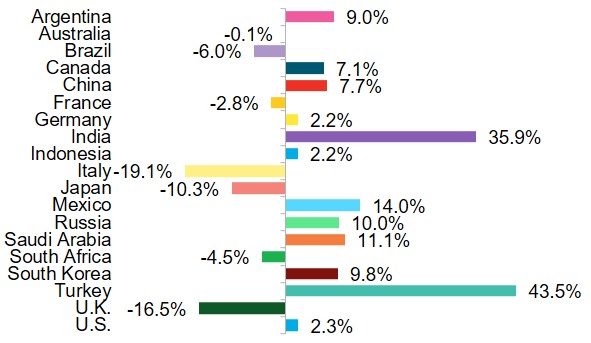Industrial Energy-Efficiency Measures
Establish and enforce industrial energy efficiency standards
Overview
Industrial energy-efficiency measures contribute to decarbonization by reducing energy consumption and thus emissions. Energy-efficiency measures are sometimes called the ‘low hanging fruit’ of climate policy because some require little change or outlay (in the long term it may reduce expenditure). They can also create jobs more quickly compared with other approaches – an important consideration for governments wanting to bolster the economy.
Impact
Broadly speaking, industry has less efficiency potential compared with other areas of the economy (eg, buildings): energy accounts for such a significant share of operating costs that companies are already incentivized to be as efficient as possible. Estimates of potential efficiency savings are around 15-20%. In addition, energy efficiency may not contribute to decarbonization if the facility and equipment need to be changed anyway.
The scale of efficiency potential varies across industrial sectors, countries and plants: overall, the G-20 increased industrial energy consumption 5% on average over 2014-2018. But this belies the significant cross-country variation, with India and Turkey seeing rises of 36% and 44% and developed countries having declines of 17% (U.K.) and 19% (Italy). However, this partly illustrates the shift in the location of industrial economic activity. What is of more importance is the industrial energy consumption per unit of output. Developing economies including India, South Korea and China have seen significant decreases in recent years thanks to building newer, more efficient production infrastructure.
Some countries that have seen the deepest cuts in industrial energy consumption have implemented market-based financial incentives together with binding energy-efficiency targets in what is known as ‘white certificate’ programs. India’s Perform, Achieve and Trade (PAT) scheme sets efficiency goals for large energy-intensive companies. The program helped reduce the participants’ total energy consumption by 5.3% from 2012-2015 – 1.2 percentage points beyond the target. It also helped lower CO2 emissions by 31 million metric tons (2% of India’s total) 2012-2015 and yielded cumulative investment in energy-efficient technologies of some 261 billion rupees ($3.7 billion).
Other countries with histories of energy-efficiency gains have introduced targets without associated certificate schemes: China’s Top Industrial Energy Conservation Programs also set goals, with a carrot-and-stick approach: companies had to undertake various measures (energy audits, conservation projects such as phasing out inefficient technologies, etc.) but could also benefit from subsidies and training. The policy was aided by China’s top-down governance system and energy intensity targets are also included in the Five-Year Plans, helping to strengthen the political commitment. The scheme achieved 124% of the energy-saving target for 2015, and took the country a third of the way toward its national efficiency target of a 16% reduction in energy intensity from 2010 levels.

Source: IEA, OECD, BloombergNEF.

Source: IEA, OECD, BloombergNEF. Note: * Based on value added of industry (including construction, in current U.S. dollars).
Opportunity
As well as energy-efficiency schemes, governments have also seen success by introducing financial incentives such as grants and loan schemes. For example, Italy’s National Energy Efficiency Fund supports initiatives to reduce energy consumption in industrial processes, among others, while the Korea Energy Agency offers low-interest loans toward energy-saving technologies.
Others have gone one step further by implementing product-related regulations or obligations: the EU Ecodesign Directive, for example, requires manufacturers to improve the environmental performance of their energy-related products. However, the effectiveness of such policies rests in part on the enforcement framework, which was strengthened as compliance has been patchy: a tenth of potential energy savings from this directive and related labeling rules was lost due to poor enforcement, according to a 2014 evaluation funded by the European Commission.
Technical resources such as training and information-raising campaigns are also important to promote energy efficiency in industry. As a first step, companies need to measure and evaluate energy-consumption data, to pinpoint where to invest in efficiency measures. With funding from the EU and development bank GIZ, the Argentinian government has set up five ‘Energy Efficiency Learning Networks’, with the 68 participating companies accounting for 15% of the country’s industrial energy consumption (by end-2020). As part of the initiative, the participants agree on goals and receive technical support to achieve them. Each Network has seen savings of 4-7% in power consumption and 5-8% for natural gas, the government estimates.
Despite this policy support, policy makers may also need to address several other barriers to energy-efficiency savings in industry: utilities and state-owned companies may not be permitted to take part in energy-efficiency programs. Alternately, the regulations they operate under may favor capex projects over operating-cost reductions through energy-efficiency measures. Companies also often have long, fixed planning cycles which may do not align with the application and payment schedules of policies. In addition, as in the building energy-efficiency sector, split incentives can arise between parent and subsidiary companies if the former pays for capital investments, while the latter benefits from the cost savings from lower energy bills.
Source
BloombergNEF. Extracted from G20 Policy Scoreboard report published on February 1, 2021. Learn more about BloombergNEF solutions or find out how to become a BloombergNEF client.
Read next
Related actions
Establish and enforce industrial energy efficiency standards
- Industry and Materials
- Companies